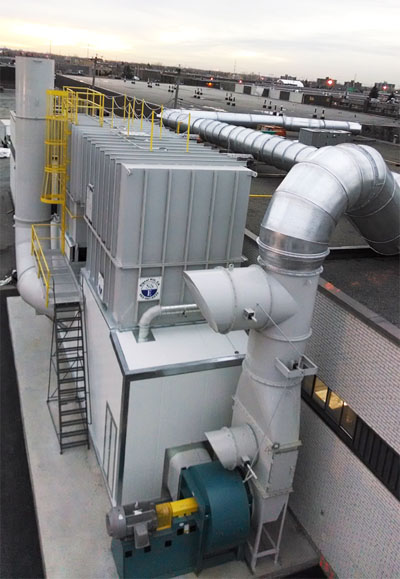
5 Steps To RTO Longevity (Part 2)
December 1, 2016 6:00 am5 Steps To RTO Longevity (Part 2)
2. Compressed Air Quality
Compressed air quality has a direct impact on the operational reliability of your Regenerative Thermal Oxidizer (RTO’s) system. Moisture in the compressed air supply will eventually degrade pneumatic components affecting poppet valve operations (especially in winter conditions) and control sensing lines.
The use of a desiccant air dryer, especially in cold climate applications, ensures proper compressed air quality (clean dry air supply to -40 °F dew point).
Proper compressed air system design is essential to moisture content. Drip legs should be incorporated for water and debri collection and drainage. Lines should be copper or stainless steel to prevent possible corrosion.
Finally, in cold weather climates, the addition of strategically placed add on heat tracing elements backstops overall system operating integrity.

3. RTO Project Design
Initial RTO sizing and design needs to take the following process criteria into account:
- Review of process exhaust air volumes, including current conditions and any accommodation of future process expansion. This includes variable process conditions (Min/Max or variable source conditions).
Review of process exhaust constituents- This includes any particulate and/or corrosive component in the exhaust flow. This is important since the presence of acid forming compounds may require the use of acid gas scrubbers following the RTO to comply with regulations. Alternately, particulates may necessitate the use of filtration equipment upstream of the RTO to protect heat exchange media from blockage that can affect performance.
- Understanding minimum, average, and peak solvent loading operating conditions. This can affect system initial heat recovery design or whether a hot gas bypass is required. This can also affect secondary heat recovery design possibilities with the system.
- Proper location of the system will result in reduced material (i.e. ductwork costs) and reduced utility consumption.
- Understanding potential rebates and incentives that could result from the purchase of air pollution control equipment. A complete understanding of all process operating conditions can prevent costly design mistakes upfront in the project design process. Read more
4. Compliance Testing
One common mistake that customers make is to test the Regenerative Thermal Oxidizer (RTO’s) equipment above the operational parameters defined in the permit. This can be a costly error for long-term equipment operation. When the RTO is tested at a higher destruction level than is required by the permit, this can become the baseline operating condition and allows for no decrease in performance as the equipment ages. As the RTO ages, equipment such as valve seats will require more maintenance. Therefore, the The Regenerative Thermal Oxidizer equipment is out of the established baseline compliance.
5. Effective Maintenance
A good maintenance program will pay for itself by ensuring that the system is run at peak efficiency. A comprehensive inspection and preventive maintenance plan minimizes the risk of unexpected downtime, while maximizing production uptime. A good inspection/maintenance plan encompasses the following services.
- Routine inspection by a highly qualified oxidizer service provider.
- Regular maintenance on a daily, weekly, and monthly basis.
- Inventory of key spare parts for fast repair.
- Regular review of operating conditions for comparative analysis to make sure there is no deviation from baseline process or equipment operation.
The oxidizer efficiency needs to be at peak performance to minimize operating costs and reduce greenhouse emissions. Making informed decisions for your oxidizer system requires having a comprehensive plan that is able to identify and respond to small problems, avoid catastrophic breakdowns, and track historical operating /cost information over the life of the unit for optimal operation. The responsible manager should periodically review the overall maintenance program to fine tune operating and maintenance programs.
Recommendations
Specifying and purchasing an RTO can be a daunting task with many potential pitfalls. By careful specifying the process exhaust conditions with all their variability, it’s possible to purchase an RTO that will provide long-term operation with high performance. By working with Ship & Shore Environmental’s personnel, overcoming and avoiding the pitfalls of identifying and purchasing an RTO can be achieved. Avoiding the pitfalls includes the following benefits:
- Ensuring that the compressed air quality provides for proper functioning of the valve system.
- Construction of the RTO with materials and/or coatings that will protect the unit for long-term life.
- Fully understanding and evaluating the project design to engineer an RTO system to function under all of the defined process parameters, ensuring an RTO system that will operate and perform as expected.
- That the operating window is sufficient to allow for operation until maintenance can be performed.
- Ship & Shore can provide a maintenance program tailored to each individual customer’s needs with services and visit frequency determined jointly.
Call our Experts for a Free & Confidential Initial Consultation based on your needs 562-997-0233.
Categorised in: Green Energy, Industry news, RTO, Ship & Shore

